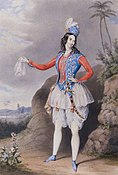
For social reasons, female roles were played by boys or men in many early forms of theatre, and travesti roles continued to be used in several types of context even after actresses became accepted on the stage. The popular British theatrical form of the pantomime traditionally contains a role for a "principal boy", a breeches role played by a young woman, and also one or more pantomime dames, female comic roles played by men. Similarly, in the formerly popular genre of Victorian burlesque, there were usually one or more breeches roles.
Etymology[edit]
The word means "disguised" in French. Depending on sources, the term may be given as travesty,[1][2] travesti,[3][4] or en travesti. The Oxford Essential Dictionary of Foreign Terms in English explains the origin of the latter term as "pseudo-French",[5] although French sources from the mid-19th century have used the term, e.g. Bibliothèque musicale du Théâtre de l'opéra (1876), La revue des deux mondes (1868), and have continued the practice into the 21st century.[6]








